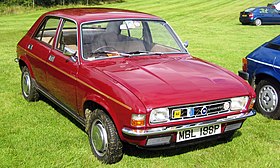
Back Austin Allegro Danish Austin Allegro German Austin Allegro Spanish آستین الرگو Persian Austin Allegro Finnish Austin Allegro French Austin Allegro ID Austin Allegro Italian オースチン・アレグロ Japanese Austin Allegro Dutch
This article includes a list of general references, but it lacks sufficient corresponding inline citations. (June 2020) |
| Austin Allegro | |
|---|---|
 | |
| Overview | |
| Manufacturer | Austin (British Leyland) |
| Also called |
|
| Production | 1973–1982 |
| Assembly | United Kingdom: Longbridge, Birmingham Belgium: Seneffe Italy: Lambrate, Milan (Innocenti) |
| Designer | Harris Mann |
| Body and chassis | |
| Class | Small family car (C) |
| Body style | 2-door saloon 3-door estate 4-door saloon |
| Layout | FF layout |
| Powertrain | |
| Engine | 1.0 L A-Series I4 1.1 L A-Series I4 1.3 L A-Series I4 1.5 L E-Series I4 1.7 L E-Series I4 |
| Dimensions | |
| Wheelbase | 2,438 mm (96 in) |
| Length | 3,861 mm (152 in) (saloon), 3,993 mm (157.2 in) (estate) |
| Width | 1,600 mm (63 in) |
| Height | 1,397 mm (55 in) |
| Kerb weight | 869 kg (1,915 lb) (approx) |
| Chronology | |
| Predecessor | Austin 1100/1300 |
| Successor | Austin Maestro (Hatchback) Austin Montego (Saloon) |
The Austin Allegro is a small family car that was manufactured by the Austin-Morris division of British Leyland (BL) from 1973 until 1982. The same vehicle was built in Italy by Innocenti between 1974 and 1975 and sold as the Innocenti Regent. The Allegro[2] was designed as a replacement for the Austin 1100 and 1300 models. In total, 642,350 Austin Allegros were produced during its 10-year production life, most of which were sold on the home market, less than a third of 2.1 million 1100s and 1300s sold in the previous 11 years.
It was built and sold by British Leyland alongside the hatchback Austin Maxi (launched in 1969) and the 1971 rear-wheel-drive Morris Marina. All three were eventually replaced by the Austin Maestro in 1983.
- ^ The Vanden Plas Owners Club Retrieved on 18 February 2013
- ^ Sales hopes pinned on new Austin Allegro. The Times, Thursday, 17 May 1973; pg. 1; Issue 58784